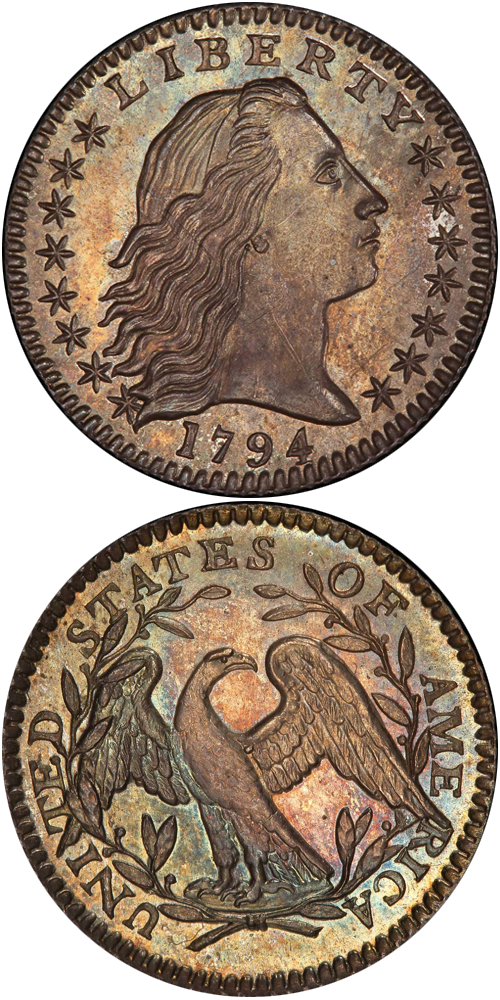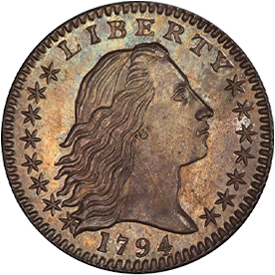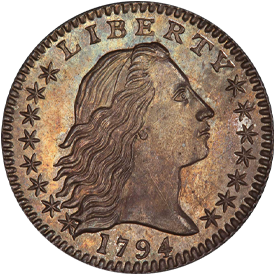Designed by: Robert Scot
Issue Dates: 1794-1795
Composition: 89.24% silver, 10.76% copper
Diameter: 16.5 mm
Weight: 1.34 grams (20.8 grains)
Edge: Reeded
Business Strike Mintage: 86,416
Proof Mintage: None
The obverse of the 1794-1795 half dime style portrays Miss Liberty with flowing hair, facing right, with LIBERTY above and the date 1795 below. Eight stars are behind her head and seven are in front. The reverse illustrates a delicate or "small" eagle perched on a cloud, within an open wreath, with UNITED STATES OF AMERICA surrounding. Denticles are around the border, as on all half dimes from this design forward. Curiously, neither this half dime design nor the following two motifs bear a designation of denomination or value.
Of the two dates in which Flowing Hair half dimes were made, the 1795 is more often seen than 1794. Specimens of either date are typically encountered in grades from Good through Fine to Very Fine. Extremely Fine examples are elusive, and AU coins are rare. Uncirculated pieces are apt to be encountered only when great collections come on the market. Many pieces are found with a series of parallel lines or adjustment marks, produced at the Mint during the planchet preparation process. In keeping with other pieces of the era, the striking is apt to be inconsistent, and often one area or another will show some normal weakness.
Further Reading
The first large quantity production of half dimes (the "s" from disme by this time had been dropped) occurred in 1794. The obverse of the 1794-1795 style, known as the Flowing Hair type, features Miss Liberty facing to the right, with stars to the left and right borders, LIBERTY above, and the date below. The Small Eagle reverse illustrates a delicate bird perched at the center of a wreath, with the inscription UNITED STATES OF AMERICA surrounding. The piece bears no indication of denomination. Indeed, it was not until 1829 that half dimes indicated that they were worth five cents. Citizens were supposed to know the value by the size and weight. At the time the acceptance of a coin in commerce at a given value was predicated upon the metal in which the coin was struck and its apparent weight and diameter. Coins in circulation consisted of a confused jumble of foreign issues of varying sizes, weights, states of wear, and regularity. Valuations tended to be approximate.
Half dimes of 1795 are of the same design used in 1794. Many die varieties exist of these early issues, all of which are attributed in The United States Half Dimes, by D.W. Valentine, published by the American Numismatic Society in 1931. This followed the pioneering effort, The Early Half Dimes of the United States, published by Harold P. Newlin in 1883. Newlin, an attorney, enjoyed his coins (which comprised many other series in addition to half dimes) immensely, and part of his affection is evident when reading his book. Coins of the year 1802 in particular were fascinating to him. In 1984 Jules Reiver published a reference and identification system for half dimes based on the Valentine book. The current state-of-the-art reference is Federal Half Dimes 1792-1837, a work by R. J. Logan and J. Mc Closkey published in 1998.
Whereas years ago, numismatists collected half dimes by Valentine varieties, in recent decades few have been able to afford such activity. Most sets of half dimes from 1794 through the end of the series in 1873 are comprised of major date and mintmark varieties or, in the instance of type sets, one each of the major designs.
It is appropriate to mention adjustment marks, a situation common to other early silver (and gold) issues as well. Silver, a precious metal, was included in early United States coins to full intrinsic value. The half dimes of 1794 and 1795 (for example) contained approximately five cents worth of silver at the time of issue. During this period the United States monetary system was relatively new and untried, and the public was skeptical of it (is the public more confident now?). As a result, the intrinsic value concept was important to the public. Coins were given full metallic weight.
When planchets were prepared for early half dimes (bear in mind that these remarks apply to other early silver and gold coins as well) each piece was weighed to make certain it was accurate. If a piece was significantly underweight, the planchet was melted. If the piece was overweight it was scraped with a file to remove the excess metal. At one time an entire room at the Philadelphia Mint was occupied by women sitting in front of balance scales with files in hand! These file marks are still visible on many if not most half dimes of 1794-1795. These marks show up in the form of parallel striations usually visible on the obverse and reverse at the highest spots-in the hair of Miss Liberty or on the breast or wings of the eagle, or sometimes toward the rim or border. These adjustment marks are normal and are to be expected. Most advanced collectors are familiar with them, but often a beginning collector will confuse adjustment marks with scratches. Scratches, of course, are marks put on a coin after striking. Whereas scratches would seriously affect a coin's value, adjustment marks do not unless they are especially severe.
As the Mint-caused adjustment marks were made by file marks in the planchet before the coin was struck, after striking, the adjustment marks remain parallel to each other and also follow the "hills and dales" of the surface characteristics. That is, an adjustment mark might begin at the rim, continue through the border of the rim to the field, through the edge of a star, across a star, out the other side of the star, back into the field again, and so on. On the other hand, a scratch produced later would tend to be deepest on the highest parts of the coin and perhaps not visible at all in the lower areas, for the lower areas were protected by the features in relief. Further, whereas file marks or adjustment marks made on the planchet caused a removal of metal, scratches made later caused a displacement of metal, so under microscopic examination a scratch will usually show a ridge of metal on one or both sides (unless it has been worn away). Perhaps the present discussion is a bit complicated. To paraphrase the old proverb, examining one coin is worth a thousand words of description.
Although 1794 half dimes were a novelty when they were released, apparently the citizenry felt generally indifferent about them, for few if any were saved as curiosities. Issues of both 1794 and 1795 are exceedingly rare in Uncirculated grade, with 1794 being considerably the rarer of the two. Although exact mintage breakdowns are not known for the years (86,416 pieces were made for the combined period), the survival of pieces today indicates that perhaps three or four times as many 1795 half dimes were made than of those dated 1794. The typical specimen encountered today is apt to be in worn condition.
Precisely who engraved dies for various coins during the formative years of the Philadelphia Mint is not known. Research by Robert W. Julian, Walter H. Breen, Don Taxay, and other scholars has resulted in certain postulations, one of which is that Robert Scot, employed at the Mint as an engraver at the time, was the designer of the 1794-1795 half dime and certain other denominations of these years.








